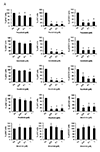Identification of Ponatinib as a potent inhibitor of growth, migration, and activation of neoplastic eosinophils carrying FIP1L1-PDGFRA
- PMID: 24407160
- PMCID: PMC4338611
- DOI: 10.1016/j.exphem.2013.12.007
Identification of Ponatinib as a potent inhibitor of growth, migration, and activation of neoplastic eosinophils carrying FIP1L1-PDGFRA
Abstract
In chronic eosinophilic leukemia, the transforming oncoprotein FIP1L1-PDGFRA is a major target of therapy. In most patients, the tyrosine kinase inhibitor (TKI) imatinib induces complete remission. For patients who are intolerant or resistant, novel TKIs have been proposed. We examined the in vitro effects of 14 kinase blockers on growth and function of EOL-1 cells, a FIP1L1-PDGFRA(+) eosinophil cell line. Major growth-inhibitory effects were seen with all PDGFR-blocking agents, with IC50 values in the low nanomolar range: ponatinib, 0.1-0.2 nmol/L; sorafenib, 0.1-0.2 nmol/L; masitinib, 0.2-0.5 nmol/L; nilotinib, 0.2-1.0 nmol/L; dasatinib, 0.5-2.0 nmol/L; sunitinib, 1-2 nmol/L; midostaurin, 5-10 nmol/L. These drugs were also found to block activation of PDGFR-downstream signaling molecules, including Akt, S6, and STAT5 in EOL-1 cells. All effective TKIs produced apoptosis in EOL-1 cells as determined by microscopy, Annexin-V/PI, and caspase-3 staining. In addition, PDGFR-targeting TKIs were found to inhibit cytokine-induced migration of EOL-1 cells. In all bioassays used, ponatinib was found to be the most potent compound in EOL-1 cells. In addition, ponatinib was found to downregulate expression of the activation-linked surface antigen CD63 on EOL-1 cells and to suppress the growth of primary neoplastic eosinophils. We also examined drug effects on Ba/F3 cells expressing two clinically relevant, imatinib-resistant, mutant forms of FIP1L1-PDGFRA, namely T674I and D842V. Strong inhibitory effects on both mutants were seen only with ponatinib. In summary, novel PDGFR-targeting TKIs may be alternative agents for the treatment of patients with imatinib-resistant chronic eosinophilic leukemia. Although several different PDGFR-targeting agents are effective, the most potent drug appears to be ponatinib.
Copyright © 2014 ISEH - Society for Hematology and Stem Cells. Published by Elsevier Inc. All rights reserved.
Figures







References
-
- Gotlib J. Molecular classification and pathogenesis of eosinophilic disorders: 2005 update. Acta Haematol. 2005;114:7–25. - PubMed
-
- Tefferi A, Patnaik MM, Pardanani A. Eosinophilia: secondary, clonal and idiopathic. Br J Haematol. 2006 Jun;133:468–492. - PubMed
-
- Bain BJ, Fletcher SH. Chronic eosinophilic leukemias and the myeloproliferative variant of the hypereosinophilic syndrome. Immunol Allergy Clin North Am. 2007;27:377–388. - PubMed
-
- Gotlib J. Chronic eosinophilic leukemia/hypereosinophilic syndrome. Cancer Treat Res. 2008;142:69–106. - PubMed
-
- Valent P. Pathogenesis, classification, and therapy of eosinophilia and eosinophil disorders. Blood Rev. 2009;23:157–165. - PubMed
Publication types
MeSH terms
Substances
Grants and funding
LinkOut - more resources
Full Text Sources
Other Literature Sources
Research Materials
Miscellaneous

